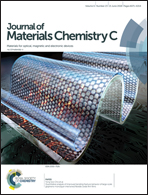Predicting multiple Dirac-cones and ultrahigh Fermi velocity in perovskite R![[3 with combining macron]](https://www.rsc.org/images/entities/char_0033_0304.gif) c phase LaCuO3†
c phase LaCuO3†
Abstract
Three-dimensional (3D) Dirac semimetal as an intermediate between a trivial insulator and topological insulator has generated much attention, yet there are currently very few experimental studies. In this study, on the basis of density functional theory calculations and a theoretical tight-binding model, we have predicted that the experimentally synthesised LaCuO3 compound (R![[3 with combining macron]](https://www.rsc.org/images/entities/char_0033_0304.gif) c phase) possesses multiple Dirac cones in its electronic structure. The bands are linearly dispersed, and the compound exhibits comparable Fermi velocity (0.92 × 106 m s−1) to that of graphene; also, the bands possess large regions of linear dispersion. More interestingly, rings of Dirac nodes formed by multiple Dirac points and a distorted Dirac cone coexist in the LaCuO3 compound. The Dirac states in LaCuO3 are protected by the D3d symmetry, with dominant contributions from the d orbitals of Cu and p orbital of O. The particular space groups allow 3D Dirac points as symmetry-protected degeneracies. Thus, there are probably numerous 3D Dirac semimetals in the perovskite (R
c phase) possesses multiple Dirac cones in its electronic structure. The bands are linearly dispersed, and the compound exhibits comparable Fermi velocity (0.92 × 106 m s−1) to that of graphene; also, the bands possess large regions of linear dispersion. More interestingly, rings of Dirac nodes formed by multiple Dirac points and a distorted Dirac cone coexist in the LaCuO3 compound. The Dirac states in LaCuO3 are protected by the D3d symmetry, with dominant contributions from the d orbitals of Cu and p orbital of O. The particular space groups allow 3D Dirac points as symmetry-protected degeneracies. Thus, there are probably numerous 3D Dirac semimetals in the perovskite (R![[3 with combining macron]](https://www.rsc.org/images/entities/char_0033_0304.gif) c) phase yet to be discovered.
c) phase yet to be discovered.
![Graphical abstract: Predicting multiple Dirac-cones and ultrahigh Fermi velocity in perovskite R [[3 with combining macron]] c phase LaCuO3](/en/Image/Get?imageInfo.ImageType=GA&imageInfo.ImageIdentifier.ManuscriptID=C8TC00872H&imageInfo.ImageIdentifier.Year=2018)


 Please wait while we load your content...
Please wait while we load your content...
![[3 with combining macron]](https://www.rsc.org/images/entities/h2_char_0033_0304.gif) c phase LaCuO3
c phase LaCuO3